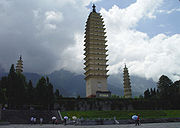
Three Pagodas
Encyclopedia

Yunnan
Yunnan is a province of the People's Republic of China, located in the far southwest of the country spanning approximately and with a population of 45.7 million . The capital of the province is Kunming. The province borders Burma, Laos, and Vietnam.Yunnan is situated in a mountainous area, with...
, China
China
Chinese civilization may refer to:* China for more general discussion of the country.* Chinese culture* Greater China, the transnational community of ethnic Chinese.* History of China* Sinosphere, the area historically affected by Chinese culture...
, dating from the time of the Nanzhao kingdom and Kingdom of Dali
Kingdom of Dali
Dali or Great Li was a Bai kingdom centred in what is now Yunnan Province of China. Established by Duan Siping in 937, it was ruled by a succession of 22 kings until the year 1253, when it was conquered by an invasion of the Mongol Empire. The capital city was at Dali.- History :The Kingdom of...
.
The Three Pagodas are located about 1.5 km (0.93205910497471 mi) north of scenic Dali, Yunnan province. They are at the east foot of the tenth peak of the massive Cangshan
Cangshan
Cangshan is a mountain range immediately west of Dali City in Yunnan province of Southwest China.The highest summit, Malong, is 4,122 m, but the mountain includes another 18 peaks all over 3,500 m altitude...
Mountains and face the west shore of the Erhai Lake
Erhai Lake
Er Lake, Chinese Erhai , is an alpine fault lake in Yunnan province, China. Its name means "Ear-shaped Sea", due to its shape as seen by locals and travellers. Er Lake was also known as Yeyuze or Kunming Lake in ancient times. A commonly-seen mistranslation is Erhai Lake.-Geography:Erhai is...
of the ancient Dali town.
Description


The main pagoda, known as Qianxun Pagoda (pinyin
Pinyin
Pinyin is the official system to transcribe Chinese characters into the Roman alphabet in China, Malaysia, Singapore and Taiwan. It is also often used to teach Mandarin Chinese and spell Chinese names in foreign publications and used as an input method to enter Chinese characters into...
Qian Xun Ta), reportedly built during 823-840 AD by king Quan Fengyou (劝丰佑) of the Nanzhao state, is 69.6 meters (227 feet) high and is one of the tallest pagodas in China’s history. The central pagoda is square shaped and composed of sixteen stories; each story has multiple tiers of upturned eaves. There is a carved shrine containing a white marble
Marble
Marble is a metamorphic rock composed of recrystallized carbonate minerals, most commonly calcite or dolomite.Geologists use the term "marble" to refer to metamorphosed limestone; however stonemasons use the term more broadly to encompass unmetamorphosed limestone.Marble is commonly used for...
sitting Buddha statue at the center of each façade of every story. The body of the pagoda is hollow from the first to the eighth story, surrounded with 3.3 meters (10 feet) thick walls. In 1978, more than 700 Buddhist antiques, including sculptures made of gold, silver, wood or crystal and documents, were found in the body during a major repairing work. The designers of the pagoda are supposed to have come from Xi’an, the capital of Tang Dynasty at that time and the location of another pagoda, Small Wild Goose Pagoda
Small Wild Goose Pagoda
The Small Wild Goose Pagoda, sometimes Little Wild Goose Pagoda , is one of two significant pagodas in the city of Xi'an, China, the site of the old Han and Tang capital Chang'an. The other notable pagoda is the Giant Wild Goose Pagoda, originally built in 652 and restored in 704...
, which shares the similar style but is one hundred years older.
The other two sibling pagodas, built about one hundred years later, stand to the northwest and southwest of Qianxun Pagoda. They are 42.19 meters (140 feet) high. Different from Qianxun Pagoda, they are solid and octagonal with ten stories. The center of each side of every story is decorated with a shrine containing a Buddha statue.
There is a lake behind them. Named (聚影池) Juying Chi (Reflection pond), the pond is known to be able to reflect images of the Three Pagodas.
History

The Three Pagodas are well known for their resilience; they have endured several man-made and natural catastrophes over more than one thousand years. Their mother building was known as Chongsheng Monastery (pinyin
Pinyin
Pinyin is the official system to transcribe Chinese characters into the Roman alphabet in China, Malaysia, Singapore and Taiwan. It is also often used to teach Mandarin Chinese and spell Chinese names in foreign publications and used as an input method to enter Chinese characters into...
Chong Sheng Si, also known as SanTa Si, Tianlong Si) and was once the royal temple of the Kingdom of Dali
Kingdom of Dali
Dali or Great Li was a Bai kingdom centred in what is now Yunnan Province of China. Established by Duan Siping in 937, it was ruled by a succession of 22 kings until the year 1253, when it was conquered by an invasion of the Mongol Empire. The capital city was at Dali.- History :The Kingdom of...
. It was originally built at the same time as the first pagoda, but was destroyed in a fire during the rule of the Qing Dynasty
Qing Dynasty
The Qing Dynasty was the last dynasty of China, ruling from 1644 to 1912 with a brief, abortive restoration in 1917. It was preceded by the Ming Dynasty and followed by the Republic of China....
. The temple was later rebuilt in 2005. It was recorded that Qianxun Pagoda had been split in an earthquake on May 6, 1515 AD (Ming Dynasty
Ming Dynasty
The Ming Dynasty, also Empire of the Great Ming, was the ruling dynasty of China from 1368 to 1644, following the collapse of the Mongol-led Yuan Dynasty. The Ming, "one of the greatest eras of orderly government and social stability in human history", was the last dynasty in China ruled by ethnic...
). However, it miraculously recovered ten days later in an aftershock. The most recent record of severe earthquake in the Dali area occurred in 1925. Only one in one hundred buildings in Dali survived, but the Three Pagodas were undamaged.
The central Qianxun Pagoda was built sometime in the latter half of the 9th century (after the Kaicheng period, 836–840). During repairs in 1979, three copper plates were found at the bottom of the steeple which recorded the exact years of previous repairs, those being 1000, 1142, and 1145.
See also
- List of Buddhist temples
- Chinese architectureChinese architectureChinese architecture refers to a style of architecture that has taken shape in East Asia over many centuries. The structural principles of Chinese architecture have remained largely unchanged, the main changes being only the decorative details...
- Architecture of the Song DynastyArchitecture of the Song DynastyThe architecture of the Song Dynasty was noted for its towering Buddhist pagodas, enormous stone and wooden bridges, lavish tombs, and palaces. Although literary works on architecture existed beforehand, architectural writing blossomed during the Song Dynasty, maturing into a more professional...

